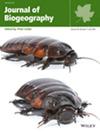Two classes of mechanisms offer opposing explanations for biodiversity patterns: Equilibrium and nonequilibrium dynamics. While not necessarily mutually exclusive, studies investigating their relative support have shown mixed results. Thus, contrasting these mechanisms across multiple taxa in the same geographic area can provide valuable insights into their role in explaining different biodiversity facets. Here, we evaluated which variables representing these dynamics best explain functional and taxonomic diversity of four tetrapod clades in a global hotspot.
Atlantic forest.
Terrestrial vertebrates.
We used climate, primary productivity and topography heterogeneity as proxy for equilibrium dynamics, and diversification rate and assemblage age as proxy for nonequilibrium dynamics. After that, we used spatially explicit structural equation models based on generalised least squares models to test how species richness and trait diversity are influenced by these dynamics processes. Furthermore, we spatialized the variables for each group and tested whether they were congruent.
Diversification rate was a strong positive driver of species richness and trait diversity, while climate was both an indirect and direct negative driver of richness and trait diversity. Furthermore, we found a congruent pattern of richness between endotherms, but not between ectotherms. In contrast, the spatial distribution of trait diversity, assemblage age and diversification rate was distinct for each group.
High diversification rates and climatic conditions played a key role in determining trait diversity and species richness. In addition, species richness and trait diversity responded to the same variables across tetrapod lineages but showed different spatial patterns. This supports the idea that both dynamics operate together to explain community assembly at a regional scale. Our findings suggest that the dichotomy between these two classes of mechanisms may not sufficiently explain diversity patterns in biodiverse and climatically complex environments such as the Atlantic Forest.


